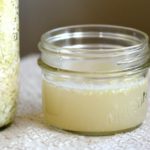Homemade Vegetable Starter Culture
Here’s how to use the natural bacterial cultures on the leaves of cabbage to create a super-concentrated vegetable starter culture. See the section above for other options to kick-start vegetable ferments.
- Prep Time: 10 minutes
- Total Time: 10 minutes
- Yield: 1 cup 1x
- Category: Culture
- Method: Fermenting
- Diet: Vegan
Ingredients
Units
Scale
- 1 medium-sized head of cabbage (organic is best)
- 1 Tbsp salt
- 1 cup (250 mL) chlorine-free water
Instructions
- This vegetable starter recipe also results in a very simple and basic sauerkraut. So once you’ve drained off the extra liquid, feel free to let it continue fermenting.
- Wash the cabbage and remove the outer leaves if necessary. Grate the cabbage into a large bowl. Toss it with the salt, then pack it into two 1-quart (1 L) jars or a 1.5 L jar. Use a wooden spoon to press the cabbage down into the jar. Leave at least 1 inch (2.5 cm) of room at the top because it will bubble a lot.
- Divide the water between the jars. It will take a minute for the water to make its way to the bottom of the jar, so add it slowly.
- Since the liquid will be used as a starter culture, it’s important to prevent contamination. Cap the kraut with a lid that will allow CO2 to escape. Fido jars or pickle pipes are perfect.
- Place the jars somewhere dark to ferment. It will start to bubble within 24 hours and remain very active for 2 to 3 days. The goal is to strain off the liquid when the sauerkraut is actively bubbling. So about 24 hours after it starts bubbling or 2 days after it was packed in the jar.
- The easiest way to strain off the brine is to use a clean spoon to hold back the cabbage while you drain the brine. I recommend pouring boiling water over the spoon before you use it to kill any microorganisms that might be on its surface, to make sure that it won’t contaminate your brine. Press the cabbage down into the jar to get most of the liquid out of the kraut.
- The remaining sauerkraut can either be left to continue fermenting or placed in the fridge for fresh and sweet sauerkraut.
- The brine needs to be frozen right away to ensure that it remains full of active cultures. Either freeze in small freezer containers or an ice cube tray. Store the frozen brine ice cubes in a zip-top bag. Your homemade vegetable starter should last for at least 6 months in the freezer.
- To use your homemade vegetable starter, defrost it in the fridge for 24 hours before use. Use about 2 Tbsp of starter per quart-sized jar of fermented vegetables.
Notes
- All cabbages should have bacterial cultures on their leaves. However, using locally grown, organic cabbage is the best way to ensure it’s teaming with lots of good bacterial culture.
- When making starters, it’s important to make sure everything is clean and sanitized. I usually do this by pouring boiling water over my tools and in my jars. That should be enough to kill most surface bacteria, yeasts, and molds.
